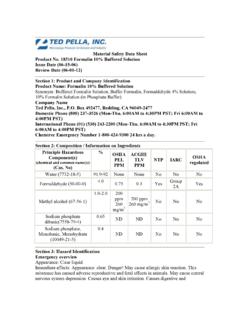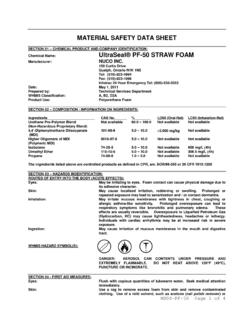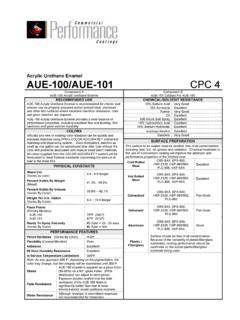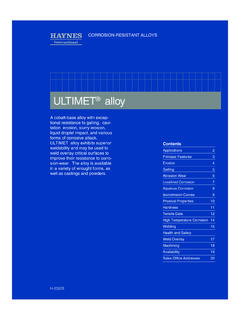Transcription of GGB DU and DU-B - GGB Bearing Technology
1 An EnPro Industries companyThe Global Leaderin High Performance Bearing SolutionsGGB DU and DU-B Metal-Polymer Self-lubricating Bearing SolutionsQualityAll the products described in this handbook are manufactured under DIN EN ISO 9001, ISO/TS 16949 and ISO 14001approved quality management addition GGB North America has been certified AS9100 revision B complying with the requirements of aerospaceindustry s quality management system for the manufacture of metal-backed bearings and filament wound bearings approvals:Tested and approved by MPA Stuttgart (for DU B) for structural bearings for civil engineering Sheet .. for Bearing designcalculations .. 225 Lubrication .. 23 Hydrodynamic lubrication .. 23 Mixed film lubrication .. 24 Boundary lubrication .. ofLubricated DU bearings .. Guidance forLubricated Applications .. forlubricated operation .. Surface Finish forlubricated operation .. forlubricated operation .. Lubrication.
2 266 Bearing Assembly .. 27 Dimensions and Tolerances .. forThermal Expansion .. forminimum clearance .. 27 Sizing .. Design .. 29 Fitting of cylindrical bushes .. 29 Fitting of flanged bushes .. 29 Insertion Forces .. 29 Alignment .. 30 Sealing .. Location .. 30 Fitting of Thrust Washers .. 30 Slideways .. 317 Modification .. and Machining .. 32 Drilling Oil Holes .. 32 Cutting Strip Material .. 32DU Components .. 32 Mating Surfaces .. 321 Introduction .. andAdvantages .. Forms Available .. 62 Material .. Wear Mechanism .. , Mechanicaland Electrical Properties .. Properties .. 10 Electrochemical Corrosion .. Properties .. 103 Performance .. Factors .. 12 Calculation .. Load p .. Load Limit plim .. Speed U .. 13 Continuous Rotation .. 13 Oscillating Movement .. Factor .. Factors .. 14 Temperature .. 14 Mating Surface .. 15 Bearing Size .. 15 Bore Burnishing .. 16 Type of Load.
3 Of Bearing Size .. 17 Calculation for Bushes .. 17 Calculation for Thrust Washers 17 Calculation for Slideways .. of BearingService Life .. 18 Specific load p .. 18 High load factor aE .. 18 Modified pU Factor .. 18 Estimation of Bearing life LH .. 19 Bore Burnishing .. 19 Slideways .. Examples .. 204 Content8 Standard Products .. Cylindrical Bushes .. Flanged Bushes .. Flanged Washers .. Thrust Washer .. Cylindrical Bushes .. Flanged Bushes .. Cylindrical Bushes - Inch sizes .. Thrust Washers - Inch sizes .. Strip .. Strip .. Strip - Inch sizes .. 509 Test Methods .. ofWrapped Bushes .. 51 Test A of ISO 3547 Part 2 .. 51 Test B (alternatively to Test A) . 51 Test C .. 51 Measurement of Wall Thickness(alternatively to Test C) .. 51 Test D .. 51 Formula Symbols andDesignations .. 53 Product Information .. 5551 Introduction1 IntroductionThe purpose of this handbook is to providecomprehensive technical information onthe characteristics of DU bearings.
4 The information given permits designers toestablish the correct size of Bearing requi-red and the expected life and performance. GGB Research and Development servicesare available to assist with unusual information on the range of DUstandard stock products is given togetherwith details of other DU is continually refining and extendingits experimental and theoretical knowledgeand, therefore, when using this brochure itis always worth-while to contact the Com-pany should additional information berequired. As it is impossible to cover all conditions ofoperation which arise in practice, custo-mers are advised to carry out prototypetesting wherever is suitable for rotating, oscillating, reciprocating and sliding available are DU related materialcompositions for specific applications, forexample when increased corrosion resi-stance of the Bearing material is requireddue to atmospheric or environmental consider-ations food safety and Advantages DU requires no lubrication Provides maintenance free operation DU has a high pU capability DU exhibits low wear rate Seizure resistant Suitable for temperatures from-200 to +280 C High static and dynamic load capacity Good frictional properties with negli-gible stick-slip Resists solvents No water absorption and thereforedimensionally stable DU is electrically conductive andshows no electrostatic effects DU has good embedability and is tol-erant of dusty environments Compact and light DU bearings are prefinished andrequire no machining after Forms AvailableStandard Components available from stock.
5 These products are manufactured to Inter-national, National or GGB standarddesigns. Metric and Imperial sizes Cylindrical Bushes Flanged Bushes * Thrust Washers Flanged Washers * Strip Material* Metric sizes only61 IntroductionFig. 1:Standard ComponentsNon-Standard Components not available from stock. These products are manufactured tocustomers' requirements with or withoutGGB recommendations, and include forexample Modified Standard Components Half Bearings Flat Components Deep Drawn Parts Pressings StampingsFig. 2:Non-Standard 1: Characteristics of DU and DU-BMaterialBackingBearing LiningOperating Temperature [ C]Maximum Load plim [N/mm2]MinimumMaximumDUSteelPTFE+Lead-20 0+280250 DUBB ronzePTFE+Lead-200+ and DU-B take advantage of the out-standing dry Bearing properties of Polyte-trafluoroethylene (PTFE) and combinesthem with strength, stability and good wearresistance, excellent heat conductivity andlow thermal consists of three bonded layers: a steelbacking strip and a porous bronze matrix,impregnated and overlaid with the PTFE/lead Bearing 3:DU MicrosectionDU-BDU-B also consists of three layers, with abronze backing replacing the steel backingstrip.
6 The structure is otherwise the sameas that of DU. The bronze backing provides a high corro-sion resistance, anti magnetic propertiesand a good thermal 4:DU-B Wear MechanismFig. 5:Effect of wear on the DU Bearing surface under dry operating wear [mm]Life LH [h] beginning to smear near end of material appearance after half material life completed low wear rate starts when bronze is exposed MaterialRunning-inDuring normal operation, a DU bearingquickly beds in and the PTFE/lead overlaymaterial removed during this period, typi-cally mm, is transferred to themating surface and forms a physically bon-ded lubricant film. The rubbing surface of the Bearing oftenacquires a grey-green colour and thebronze matrix can be seen exposed overabout 10% of the Bearing surface. Anyexcess of the PTFE/lead surface layer willbe shed as fine feathery 6:Running-inAfter 50% of useful lifeFollowing the running-in period the wearrate reduces to a minimum and the per-centage of bronze exposed graduallyincreases.
7 Fig. 7:After 50% of useful lifeEnd of useful lifeAfter an extended period of operation thewear rate increases as the componentapproaches the end of its useful life as aself-lubricating Bearing . At this stage atleast 70% of the Bearing surface will beexposed bronze, and wear will have 8:End of useful lifeWear of Mating SurfacesThere is no measurable wear of matingsurfaces made from recommended materi-als unless a DU Bearing is operatedbeyond its useful life or becomes contami-nated with abrasive , Mechanical and Electrical PropertiesTable 2: Properties of DU and DU-BCharacteristicSymbolValueUnitComment sDUDU-BPhysical PropertiesThermal Conductivity 4060W/mKafter running of linear thermal expansion : measured on strip mm to surface 1111861/10 Knormal to surface 2303661/10 KMaximum Operating TemperatureTmax+280+280 CMinimum Operating TemperatureTmin 200 200 CMechanical PropertiesCompressive Yield Strength c350300N/mm measured on disc 25 mm diameter x mm LoadStaticpsta,max250140N/mm Dynamicpdyn,max140140N/mm Electrical PropertiesSurface ResistanceROB1 101 12 depends on applied pressure and contact area Nuclear Radiation ResistanceMaximum Thermal Neutron doseDNth2 x 10152 x 1015nvtnvt = thermal neutron fluxMaximum gamma ray doseD 106106Gy = J/kg1 Gray = 1 J/kg 102 PropertiesThe following table provides an indicationof the chemical resistance of DU and DU-Bto various chemical media.
8 It is recommen-ded that the chemical resistance is confir-med by testing if possible. Table 3: Chemical Resistance of DU and DU-BElectrochemical CorrosionDU-B should not be used in conjunctionwith aluminium housings due to the risk ofelectrochemical corrosion in the presenceof water or moisture. PropertiesDU bearings show negligible 'stick-slip'and provide smooth sliding between adja-cent surfaces. The coefficient of friction ofDU depends upon: The specific load p [N/mm ] The sliding speed U [m/s] The roughness of the mating runningsurface Ra [ m] The Bearing temperature T [ C].A typical relationship is shown in ,which can be used as a guide to establishthe actual friction under clean, dry conditi-ons after running in. Exact values may vary by 20% depen-ding on operating % CDUDU-BStrong AcidsHydrochloric Acid520--Nitric Acid520--Sulphuric Acid520--Weak AcidsAcetic Acid520-oFormic Acid520-oBasesAmmonia1020o-Sodium Hydroxide520ooSolventsAcetone20++Carbon Tetrachloride20++Lubricants and FuelsParaffin20++Gasolene20++Kerosene20+ +Diesel Fuel20++Mineral Oil70ooHFA-ISO46 High Water Fluid70ooHFC-Water-Glycol70--HFD-Phospha te Ester70ooWater20o+Sea Water20-o+Satisfactory: Corrosion damage is unlikely to : Some corrosion damage may occur but this will not be sufficient to impair either the structural integrity or the tribological performance of the.
9 Corrosion damage will occur and is likely to affect either the structural integrity and/or the tribo-logical performance of the running in, the friction may be up to50% frequent starts and stops, the staticcoefficient of friction is approximately equalto, or even slightly less than the dynamiccoefficient of progressively longer periods of dwellunder load ( hours or days) the staticcoefficient of friction on the first movementmay be between and 3 times greater,particularly before running increases at Bearing temperaturesbelow 0 C. Where frictional characteristics are criticalto a design they should be established byprototype 9:Variation of friction coefficient f with specific load p and sliding speed U at temperature T = 25 C Fig. 10:Variation of friction coefficient f with specific load p and temperature T at sliding speed U = loadp = N/mm Sliding speedU = m/sFriction coefficientf = speed U [m/s]Specific load p [N/mm ]Friction coefficient loadp = N/mm TemperatureT= 40 CFriction coefficientf = load p [N/mm ]Friction coefficient fTemperature T [ C] FactorsThe main parameters when determiningthe size or calculating the service life for aDU Bearing are: Specific Load Limit plim pU Factor Mating surface roughness Ra Mating surface material Temperature T Other environmental factors hous-ing design, dirt, lubricationCalculationTwo design procedures are provided asfollows.
10 A Bearing service life calculation basedon the permitted Bearing dimensions A calculation of the necessary bearingdimensions based on the required bear-ing service Load p For the purpose of assessing Bearing per-formance the specific load p is defined asthe working load divided by the projectedarea of the Bearing and is expressed inN/mm .Cylindrical BushThrust WasherFlanged Bush (Axial Loading)SlidewayPermanent deformation of the DU bearinglining may occur at specific loads above140 N/mm and under these conditions DUshould only be used with slow intermittentmovements. The permissible maximum load on a thrustwasher is higher than that on the flange ofa flanged bush, and under conditions ofhigh axial loads a thrust washer should ---------------=( )[N/mm ][N/mm ]p4F Do2Di2 () ------------------------------=( )pF004,Dfl2Di2 () ---------------------------------------- -=( )[N/mm ] --------------=( )[N/mm ] Load Limit plim The maximum load which can be appliedto a DU Bearing can be expressed in termsof the Specific Load Limit, which dependson the type of the loading.










